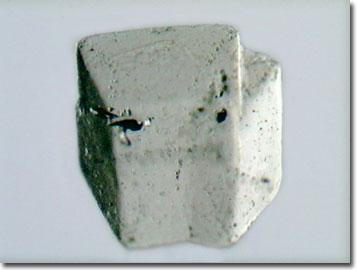Oblique Digital Image Gallery
Sodium Chloride (Table Salt) Grains
Salt has been used by mankind before recorded history as a mineral of paramount importance in regulating health, as well as in seasoning food. Sodium chloride, or common table salt, is the most familiar of the salt compounds. Also known as halite, or rock salt, this mineral forms when water evaporates from saline basins.

View a second image of crystallized sodium chloride.
Crystallized salts are translucent, and may emit a clear hue, or a variety of other colors including white, red, yellow, orange, blue, violet, green, or gray. When crystalline formations trap bacterial debris, halites exhibit delicate pink coloring.
Table salt, the universal seasoning, is finely-grained, and comprised of high-grade sodium chloride. Many commercially sold salts, which readily absorb moisture, are supplemented with small quantities of sodium aluminosilicate, tricalcium phosphate, or magnesium silicate to ensure free-flowing granules. Small quantities of potassium iodide are added to iodized table salts in order to prevent goiter (swelling in the thyroid gland), which results from dietary deficiencies of iodine.
In addition to functioning as a seasoning for foods, salts are also employed as preservatives, binders, and control agents in fermentation processes. Industrial application of salts includes the manufacture of soaps and porcelain enamel, as well as other chemicals such as sodium bicarbonate (baking soda), sodium hydroxide (caustic soda), and chlorine.
Salts, which are characterized by ionic bonds, typically exhibit relatively high melting points, and a crystalline structure when occurring as a solid. When diluted in solution or in a molten state, however, the compound typically dissociates into negatively and positively charged ions that exhibit electrical conductivity, such as in the case of electrolytes. A major cation constituent in mammalian plasma, sodium is one of the crucial elements that provide for delicate electrolyte composition in body fluids. In chemistry, the term "salt" is applied to substances that are produced by a process referred to as "neutralization" wherein an acid reacts with a base.
Contributing Authors
Cynthia D. Kelly, Thomas J. Fellers and Michael W. Davidson - National High Magnetic Field Laboratory, 1800 East Paul Dirac Dr., The Florida State University, Tallahassee, Florida, 32310.
BACK TO THE OBLIQUE IMAGE GALLERY
BACK TO THE DIGITAL IMAGE GALLERIES
Questions or comments? Send us an email.
© 1995-2025 by Michael W. Davidson and The Florida State University. All Rights Reserved. No images, graphics, software, scripts, or applets may be reproduced or used in any manner without permission from the copyright holders. Use of this website means you agree to all of the Legal Terms and Conditions set forth by the owners.
This website is maintained by our
Graphics & Web Programming Team
in collaboration with Optical Microscopy at the
National High Magnetic Field Laboratory.
Last Modification Friday, Nov 13, 2015 at 01:19 PM
Access Count Since September 17, 2002: 13424
Visit the website of our partner in introductory microscopy education:
|
|
